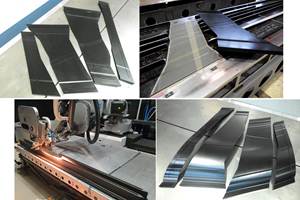Airborne completes final delivery of CFRP mirror structures for Fred Young Submillimeter Telescope
Airborne, with the help of partners, designed, manufactured and assembled two 6-meter-diameter mirror support structures for highly complex scientific telescope project.
Rendering of the Fred Young Submillimeter Telescope (FYST). Source | CPI Vertex Antennentechnik GmbH
Airborne (The Hague, Netherlands) announces the successful completion and delivery of the final components for the Fred Young Submillimeter Telescope (FYST), a space telescope designed for wide field observations and large-area surveys of stars and galaxies. Airborne’s contributions, which involved the design and manufacture of the system’s two 6-meter-diameter composite mirror support structures (MSS), marks the culmination of years of dedicated work and collaboration with partner CPI Vertex Antennentechnik (Duisberg, Germany).
The MSS structures are crucial for the FYST’s functionality, ensuring precision and stability at its final location 5,600 meters above sea level. Airborne reports that the telescope’s design is so novel that the Simons Observatory located in Northern Chile simultaneously ordered a telescope using the same basic design for its large aperture telescope, the SOLAT. The SOLAT’s MSS are identical to those of the FYST, and both projects were executed in parallel.
The FYST features an off-axis Crossed-Dragone design, consisting of a parabolic primary mirror and a large concave secondary mirror, both with a diameter of roughly 6 meters. This creates a high-throughput, wide field-of-view telescope capable of mapping the sky rapidly and efficiently. Designed to operate at submillimeter to millimeter wavelengths, the entire system has a surface error budget of just 10.7 micrometers during operation, a feat that Airborne and CPI claim has never been achieved before in this class of telescope.
For the project, Airborne’s task was to develop two very stable, passive MSS that would be virtually unaffected by gravitational forces or changes in temperature. In the final design, the mirrors sit in a semi-enclosed housing, protected yet exposed to outside temperatures ranging from -21°C to +9°C during observations. This robust design minimizes the risk of breakdowns and necessary repairs at the FYST’s installation height of 5,600 meters on Cerro Chajnantor in Chile.
A hybrid MSS using high-end carbon fiber-reinforced polymers (CFRP) was developed. The use of CFRP enables a practically zero coefficient of thermal expansion (CTE) design with high stiffness, ensuring minimal deformations. The structure consists of a thick CFRP/aluminum honeycomb sandwich top plate, on which the mirror segments are mounted, and a 3D truss structure providing global stiffness and attachment points to the rest of the telescope.
The transition from design to production involved crafting and controlling the exact ratio of resin to carbon fiber and exploiting Airborne’s Automated Laminating Cell (ALC) solution to its maximum potential. Moreover, the MSS’ assembly into transportable parts was achieved using Airborne’s design for manufacturing & assembly (DFM&A) approach, resulting in significant cost savings while ensuring extreme performance requirements.
Each of the two MSS required the assembly of around 7,000 composite parts and 12,000 other parts, using eight different specialized adhesives. The structures were assembled twice, once for the FYST telescope and once for the SOLAT telescope. Final assembly took place in Germany, close to where the trial assembly of the complete telescope is performed.
“We are proud to have played a key role in the development of the FYST,” says Jaap Dekker, composites expert at Airborne. “The final delivery signifies a significant achievement for our team and the broader scientific community.”
The FYST project was a collaborative effort involving Cornell University, a German consortium including the University of Cologne, the University of Bonn and the Max Planck Institute for Astrophysics, as well as a Canadian consortium of several universities. The telescope was assembled in Xanten, Germany, and will soon be operational, providing valuable data to researchers worldwide.
Related Content
Cryo-compressed hydrogen, the best solution for storage and refueling stations?
Cryomotive’s CRYOGAS solution claims the highest storage density, lowest refueling cost and widest operating range without H2 losses while using one-fifth the carbon fiber required in compressed gas tanks.
Read MoreComposites manufacturing for general aviation aircraft
General aviation, certified and experimental, has increasingly embraced composites over the decades, a path further driven by leveraged innovation in materials and processes and the evolving AAM market.
Read More3D-printed CFRP tools for serial production of composite landing flaps
GKN Aerospace Munich and CEAD develop printed tooling with short and continuous fiber that reduces cost and increases sustainability for composites production.
Read MoreInfinite Composites: Type V tanks for space, hydrogen, automotive and more
After a decade of proving its linerless, weight-saving composite tanks with NASA and more than 30 aerospace companies, this CryoSphere pioneer is scaling for growth in commercial space and sustainable transportation on Earth.
Read MoreRead Next
ORNL, Sierra Space create novel C/SiC TPS for reusable space vehicles
CMC tiles will be used on the Sierra Space DC100 Dream Chaser spaceplane carrying critical supplies and science experiments to and from NASA’s ISS.
Read MoreComposites support SKA Observatory radio telescope sub-reflectors
Engineering company Eosol and composites developer Compoxi work together to deliver more than 250 4.5-meter composite dishes to construct two cosmos-focused telescopes.
Read MoreJames Webb telescope reaches mirror alignment milestone, optics working successfully
Following the completion of critical mirror alignment steps, NASA’s James Webb Space Telescope has reported optical performance that could exceed original expectations.
Read More
















.jpg;maxWidth=300;quality=90)










